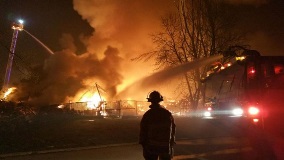A Firefighter's View

Auxiliary firefighter Keith Diakiw, P.Geo., reflects on his experience battling the Fort McMurray wildfire.
On May 3, the wildfire was wreaking havoc in Fort McMurray. Keith Diakiw, however, was taking a firefighter refresher course at Canadian Natural Resources' Horizon firehall about 80 kilometres north of the city.
An auxiliary firefighter with the company, he works as an equipment operator at the Horizon oil sands site. "By lunch, another fire auxiliary member got a call that his home was gone," he recalls. "Fort Mac was basically burning."
Canadian Natural's firefighter contingent includes six fulltime crew members and about 60 auxiliaries like Mr. Diakiw. That morning, they could only watch in shock as events unfolded in Fort McMurray.
But when a mutual aid call came in from the Regional Municipality of Wood Buffalo seeking assistance from oil sands operations in the region, members of Canadian Natural's emergency services were among the firefighters racing towards the flames to help protect the city.
It brought back memories of 2011, when Mr. Diakiw battled forest fires that threatened industry sites north of Fort McMurray. For the second time in five years, Mr. Diakiw found himself in an evacuation zone, fighting fires.
The Calm Before the Firestorm
A day earlier, Mr. Diakiw was driving north into Fort McMurray when he noticed a giant plume of smoke. He was sitting at the traffic lights on Highway 63 by the Sawridge Hotel when two fire trucks flew by going south. About eight police cars were at the intersection with their lights on. "I thought, wow, this looks serious," he says. "The fire seemed far away, yet close. It was kind of an eerie feeling."
Any concerns he had about the fire were laid to rest Tuesday morning. Up at 4:30 a.m., he headed to his bus stop as the sun was rising. The sky was blue. "It was clear as a bell. No smell of smoke," he says. Things, of course, would turn out differently. "It was the calm before the storm."
Later that afternoon, the setting was considerably less serene. As fire crews headed south into town, thousands of residents were fleeing north. They sought shelter at numerous oil sands camps in the region, including Horizon. Mr. Diakiw himself was an evacuee. He has a home in Fort McMurray, so he didn't have anything with him, not even his wallet. "It became quite chaotic for everybody."
My hat is off to those men and women firefighters who came from so far away. There were hundreds of people at the staging areas. They were there for a week or two straight, fighting the fires. - Keith Diakiw, P.Geo. Auxiliary Firefighter, Canadian Natural Resources
Mr. Diakiw was on night shift that week, so his firefighting crew first headed into Fort McMurray the evening of May 4. The fire had grown to 10,000 hectares (on its way to nearly 590,000 hectares by mid-June) and an estimated 1,600 buildings had already burned down. The city remained a battleground, surrounded and in some cases engulfed by fire.
"Driving in, you could see the charred forest on either side of the road where the firestorm went through along Highway 63," says Mr. Diakiw. "There was a lot of smoke and helicopters flying overhead. Police at all the intersections monitoring traffic."
Over the next week, he worked four shifts, fighting blazes from 6:30 p.m. to 6:30 a.m. He was one of 2,200 firefighters from Alberta, across Canada, and around the world who worked tirelessly to help save the vast majority of the community's infrastructure. "My hat is off to those men and women firefighters who came from so far away. There were hundreds of people at the staging areas. They were there a week or two straight, fighting the fires," he says.
His own crew was sent on calls across the city. While putting out hot spots in Wood Buffalo, he got his first up-close look at the destruction. Four square blocks of houses were burned to their foundations, yet streetlights were still on, casting halos in the smoke.
"You get off the truck and you're silent. All these houses are burned. You just hear running water — complete silence except for water running down the street from kitchen faucets. Everything is ash. Your heart breaks when you see the devastation, where people have lost everything."
In another community, he saw a house torn in half and vehicles flipped over. A bulldozer had attempted to create a firebreak, and it was still there, a burned-out shell. The fire was so extreme, it had melted the rims from vehicles, turning them to puddles.
The biggest blaze his crew battled was an apartment complex in Abasand. It took most of the night for several crews to put it out. "When we first saw it, our mouths dropped. The flames were about 130 feet up."
The seeming randomness of it all struck him. In Beacon Hill, where 476 homes were lost, a nearby strip mall, school, and church survived. In Abasand, a car wash burned down but the gas station beside it was untouched.
Today, the whole experience is somewhat of a blur, Mr. Diakiw says: "It felt good to do what I could to help. You're just trying to prevent more heartache for people."
He was fortunate — his own home only suffered smoke damage and he could return by mid-June.
Mr. Diakiw will always remember the support emergency responders received from across Alberta. Just as memorable is the support from neighbours, from people directly affected by the fire.
He remembers two women who had lost their homes to the fires. They showed up to cook meals and make coffee for firefighters. "They went above and beyond."
